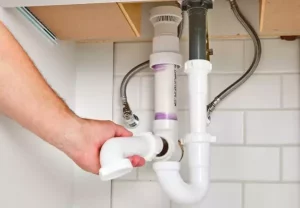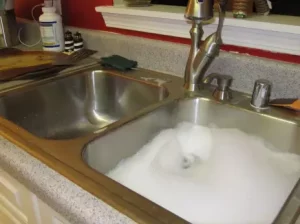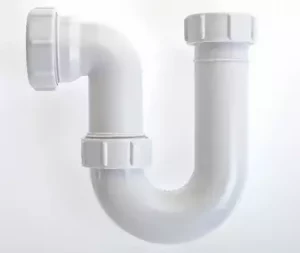A backed-up kitchen sink can wreak havoc in your house. Your sink can overflow with water and go beyond the point of being manageable. It will cause a flood, and lead to plumbing damage. This article will discuss methods for preventing kitchen sinks from backing up.
Kitchen Sink Backing up into Bathtub
What is it? You have a blocked drain. The reason that the water backs up into the bathtub when the toilet doesn’t flush has to do with the fact that the bathtub is the lowest fixture in your house.
Also, the kitchen sink will back up into the bathtub when the water level in a double-bowl sink becomes high enough to overflow the partition between the bowls and to flow over into the other bowl.
In addition, when one bowl fills with water and starts overflowing into the other bowl, gravity will cause that overflow to flow out of any opening available. If there is no P-trap on the second bowl, then gravity will cause that water to flow down through the house drain and out into your yard.
When you run water down your sink, it runs down the sink drain and into a pipe called a branch drain which then dumps into another pipe called the main waste and vent or main drain line.
Cause of the Kitchen Sink Draining Into the Bathtub
The blocked sink or bath drains are the main causes. It can be as simple as a hairball in the trap, or as complicated as a problem with the main sewer line.
1. Clogged Drain
If you have a kitchen sink that is backing up into your bathtub, you probably have a clogged drain. The kitchen sink drain and the bathtub drain are usually linked together in the same pipe. When one backs up, they both back up.
Draining water from your kitchen sink into your bathtub can be a sign of a clogged drain past the p-trap. This clog can occur if your bathroom and kitchen both share the same drain or if there is a shared vent for these drains. If you have very slow drainage, you may have a clog somewhere in the pipes that run under your house.
2. Vent Stack
When a clog forms in the main vent stack, it can cause water to back up into any of the sinks or tubs connected to it. If your kitchen sink is backing up into your bathtub, it is usually because there are too many drains connected to one pipe and they have created a clogged vent stack.

The main vent stack is a vertical pipe that connects to the drainpipes underneath all of the sinks and toilets in the house and leads outside through the roof.
The main vent stack can clog due to non-flushing items that get flushed down toilets, such as baby wipes, sanitary napkins, diapers, etc.
The vent stack will also clog if a bird’s nest or leaves drop down from the roof into the top of the pipe.
The plumbing code requires that all plumbing fixtures get vented through this main vent stack to prevent a vacuum from forming in the drainage system when water flows through it.
3. Blocked Drain
If you notice that only one side of your double sink drains slowly, it indicates a partial blockage in one of the pipes leading to your bathtub’s drain. A blockage can also develop in the main sewer line leading away from your house. Over time, grease and other debris can build up inside these pipes and cause an obstruction.
If you have a kitchen sink draining into the bathtub, you most likely have a blocked drainpipe somewhere in the line. The line has to be clear using a plunger or snake. If you use a snake, make sure you run it from the kitchen side of the wall. If you have an air gap under your sink, remove and clean out that first before doing anything else.
Read an article on how to remove food stuck in the sink with ease.
How to Fix Kitchen Sink Backing Up Into Bathtub
To correct this problem you need to determine what is causing the blockage. If you feel comfortable doing so, take the trap off under your sink and see if there is an obstruction in it.
If there is, continue unclogging the drain. If there is not an obstruction, then you may have a blockage in your main sewer system due to debris, roots, or even dirt that has gotten into your line and created a clog. In this case, you may need to contact a plumber for further assistance.

Certain cities require that only licensed plumbers work on the main sewer lines, so check with them first before proceeding.
The next step in fixing this problem is to remove the metal or plastic cap that covers the drain of your tub.
One can achieve this with an adjustable wrench, but you may need to use pliers if it’s stuck.
Also, use a flashlight and mirror or hold your head under the tub (be sure to not breathe any fumes). You will see a plastic pipe.
This is the overflow pipe for the tub, and you will want to remove this by turning it counterclockwise with an adjustable wrench.
With your flashlight and mirror or head under the tub, you will see another pipe below the overflow pipe that looks similar but has an elbow at one end.
This is a P-trap, because of its shape, and it’s most likely where all of your clogs are taking place. Disconnect this by turning counterclockwise with an adjustable wrench and removing the entire piece from under your tub.
Tips to Set Up (plumb) Your Kitchen Sink Drains Well
If you are installing a new kitchen sink or replacing an old one, the first step is to install the drain lines. This guide will show you how to install the plumbing underneath the sink correctly so that it drains properly and won’t leak.
1. Tools you Need
You will need a few tools and parts to complete this plumbing job. Make sure you have these items on hand before beginning the project.
- Screwdriver
- Pliers
- Adjustable wrench
- Silicone sealant (plumbers putty will work too)
- Tailpiece (also called a waste tube)
- P-trap – should be 1 1/2″ or 1 1/4″ depending on your sink size
- Pipe slip joint washers (also called basket strainers).
- Procedure
2. Remove Old Drain Lines
If you are replacing an old sink, be sure to remove the old drain lines and clean out any debris on the underside of the sink top where the new drain lines will attach.

3. Install P-Trap
The first step in installing new kitchen drains is to place a bucket underneath the sink where you will be working.
Slip one nut over each end of your p-trap, slide a washer over each of the ends, and then screw them onto your drainpipe and trap arm respectively.
Hand tightens those using pliers.
4. Install Trap Arm
Next, connect a p-trap (the curved pipe below the sink) to your drain pipe coming up from your basement or crawl space with two slip nuts and two washers.
Connect the trap arm to your P-trap, and then install another rubber gasket followed by a metal lock nut to secure it in place.
Connect one end of a slip-joint extension tube to your trap arm, with another rubber gasket and metal lock nut securing it in place. Then connect another extension tube to this one if you need extra length, using gaskets and nuts as before until you reach your main waste line or garbage disposal unit (if you have one).
5. Finally
Connect one end of the extension tube to your faucet and attach this pipe directly to your cold water supply line or use a coupling or elbow fitting if needed. If necessary, hold the bottom of this tube with channel locks so you can tighten it.

As a homeowner, I am specifically keen on home improvement. I am passionate about homes, yards, and home improvement. I blog on home ideas and reviews on solutions that make homes better.